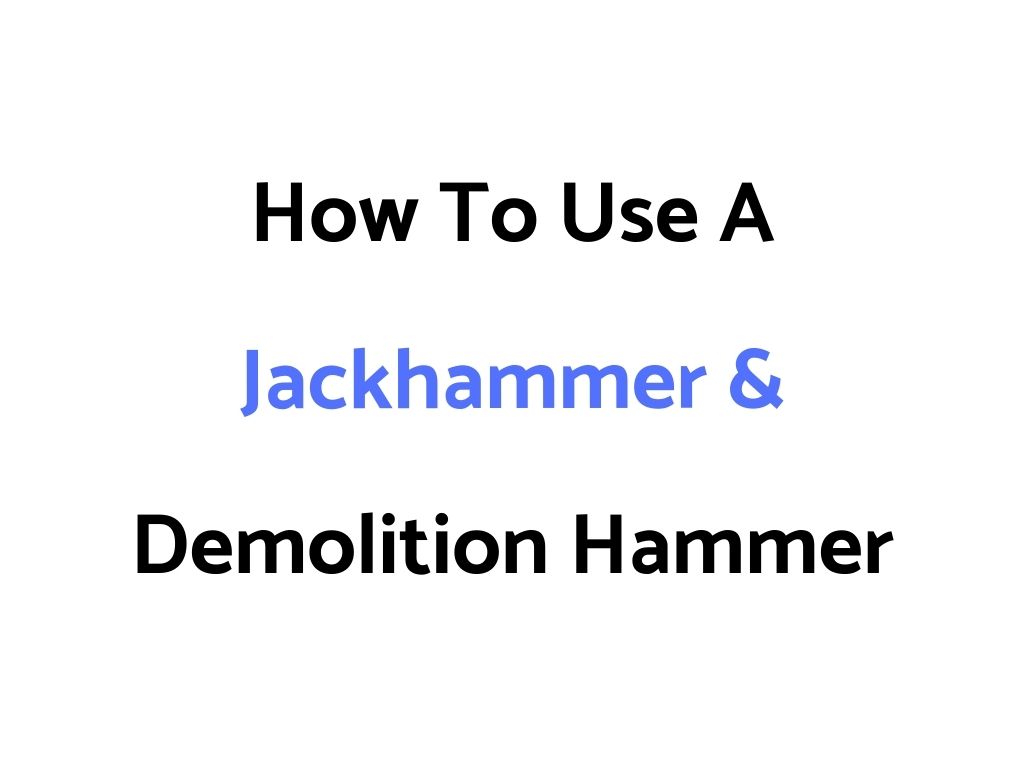Knowing how to use a jackhammer or demolition hammer is important for breaking concrete, rock, stone, pavement, asphalt, render on walls, and really any hard surface on the ground or walls that can be broken.
Demolition hammers are the handheld smaller tools used to break mainly horizontally into surfaces.
Jackhammers are heavier tools that are used mainly vertically (but can be used horizontally too) to break ground surfaces. Breakers are the heavy duty jackhammers used to break the hardest surfaces like concrete, pavement and asphalt.
With the amount of power and vibration going through these tools, it’s important to know not only how to use them correctly, but how to do so safely.
(*Note that this is a general information guide only, and not professional advice. Do your own research about proper safety and operating practices before using a jackhammer or demolition hammer)
How To Use A Jackhammer & Demolition Hammer
1. Use the appropriate jackhammer or demolition hammer for the task –
Sledgehammer – use a sledgehammer for very small areas you want to break if you don’t have power, or if you dont have a power hammer
Chipping Hammer – good for the smallest jobs like chipping tiles, loose mortar, masonry and loose concrete
Demolition hammers – good for smaller-medium jobs like breaking tiles, masonry, concrete and render/stucco
Regular Jackhammer – good for medium jobs like breaking tiles, masonry, concrete, render/stucco and small concrete slabs. A 5ft by 5ft area can be broken up with a standard jack hammer in less than an hour.
Heavy Duty Jackhammer – good for medium-larger jobs like breaking tiles, masonry, concrete, breaking small areas of pavement and asphalt, render/stucco and structural wall and floor breaking
Breaker – good for the hardest surfaces and toughest jobs like breaking tiles, masonry, concrete, render/stucco, structural wall and floor breaking, digging and trenching, pavement and asphalt breaking
You can read more about the different types, models and brands of demolition hammers, jackhammers and breakers in Best Demolition Hammer & Jackhammer: Buyer’s Guide & Reviews.
2. Attach the appropriate bit or attachment for the task into the hammer.
Some of the more common bits are
Flat Chisel – for chipping, breaking and lifting. There are both wide and narrow ended chisels
Bull Point Chisel – for mainly breaking and pointed chiselling
Clay Spade Bit – for digging and trenching clay, gravel and hard packed earth. They have a rounded end
Asphalt Cutting Bit – looks like the clay spade bit, except it has a flat sharp edge for breaking asphalt
Drill Bit – for drilling into concrete and hard surfaces
The standard bit is 1-1/8″ thick/diameter, and are made from demo steel.
2. Mark the area you want to demolish, break or chips, and switch the hammer power on before you put it in contact with the surface/material.
Get a good grip and handle on the tool –
A demolition hammer will have two grips – a side grip and the main handle.
Jackhammers usually have the same setup, with a swivelling/360 rotating side grip, or sometimes two stationary side handles on either side of the tools for maximum stability on the big pavement breakers.
3. Put the tool in contact with the surface you want to break at a slight angle. Note that pushing down harder with the hammer does little to nothing to increase force – let the tool do the work itself and just angle it or guide it.
Change the speed of the tool if required if it comes with variable speed control – change the bit speed to less or more blows per minute (bpm).
You can change the angle at which you break into the surface manually by changing the angle of the tool yourself, or, some demolition hammers come with a variable chisel angle setting which you can change.
4. If a bit ever gets stuck in the material you are trying to chip or break, you are likely trying to go too deep with the bit without breaking the surrounding surface first.
If this happens, remove the bit and use another bit to free the stuck bit by chipping around it.
Jackhammer & Demolition Hammer Safety Tips
Wear the proper safety equipment – steel cap boots (in case you drop the jackhammer), eye protection/glasses, dust mask (especially when dealing with concrete and brick dust), gloves (for the vibration) and ear protection/ear plugs or muffs.
BIG SAFETY TIP – always check whether the wall or floor you are demolishing is structural in anyway – if you break structural elements of the surface, the whole surface can fail e.g. a concrete balcony
When digging and trenching, always get a report on the services in the ground beforehand – know where the electrical conduits and water services are. Disconnect power if required
Make sure no one else is standing in the area you are demolishing
Never use a demolition hammer to break materials directly over your head
When demolishing walls, break smaller portions at a time so large debris don’t fall on your legs or feet
Keep electrical cords untangled and never operate when raining or in wet areas
Maintain the bit of the demo hammer or jackhammer – always check it isn’t broken before use
Who Makes The Best Jackhammer & Demolition Hammer
If you would like to read more about the best brands and models, you can read reviews and a buyer guide in Best Demolition Hammer & Jackhammer: Buyer’s Guide & Reviews.
How To Use A Jackhammer & Demolition Hammer – Resources
1. https://tooljuice.com/best-demolition-hammer-jackhammer-buyers-guide-reviews/
